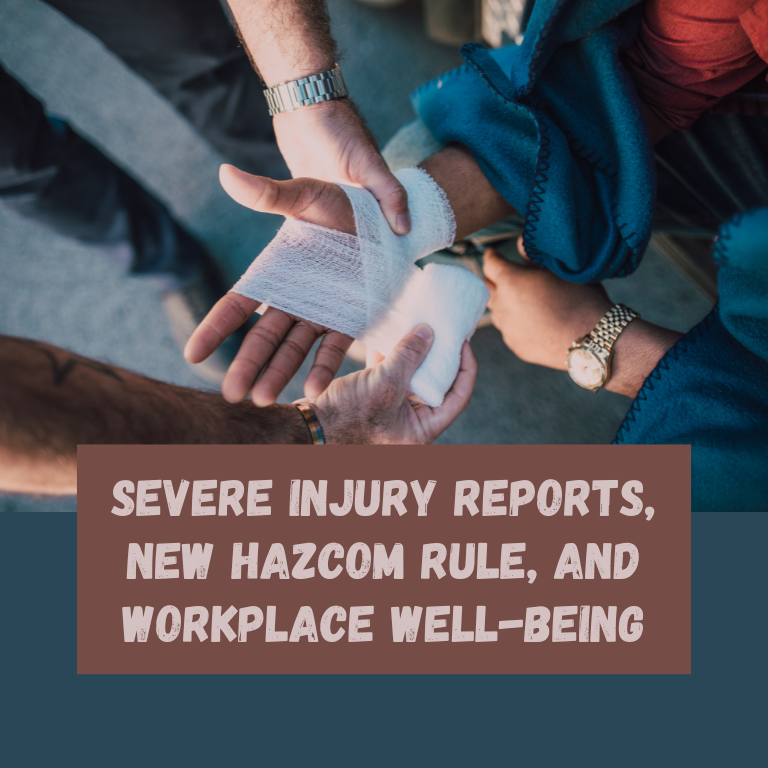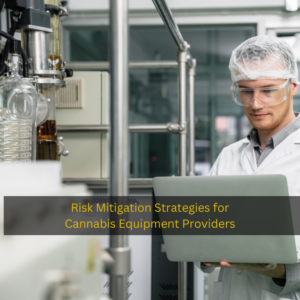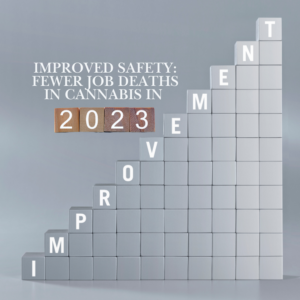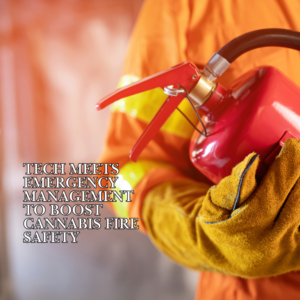Severe Injury Reports, New HazCom Rule, and Workplace Well-being

Severe Injury Reports, New HazCom Rule, and Workplace Well-Being in the Cannabis Industry
As the cannabis industry expands, so too do the responsibilities and regulations related to health and safety in the workplace. The sector, though relatively new, is heavily regulated, and cannabis businesses must comply with both federal and state health and safety standards. Recent developments in workplace safety regulations, such as new Hazard Communication (HazCom) rules and severe injury reporting requirements, highlight the growing focus on worker well-being in the cannabis industry. In this article, we will explore the importance of these regulations, their impact on the cannabis workforce, and how businesses can create a safer, more compliant environment.
The Cannabis Industry and Workplace Safety Challenges
The cannabis industry, encompassing cultivation, processing, manufacturing, and retail, presents unique safety challenges. Employees work in environments that may expose them to hazardous chemicals, machinery, and the risks associated with repetitive tasks, all of which pose potential safety threats.
Cultivation sites involve the use of pesticides and fertilizers, which, if not handled properly, can cause health risks. Processing plants, where cannabis is extracted and refined, often use chemicals like solvents that are flammable and harmful to health. Even retail locations, where employees frequently handle cash and products, are at risk of robberies and violent incidents.
Given these factors, ensuring that cannabis businesses comply with health and safety standards is not just about regulatory compliance—it’s about protecting employees’ well-being in an industry that is still developing its safety protocols.
Understanding Severe Injury Reporting in the Cannabis Industry
The Occupational Safety and Health Administration (OSHA) requires all businesses, including cannabis operations, to report severe workplace injuries and illnesses. This includes any incident resulting in an employee’s hospitalization, amputation, or loss of an eye, as well as fatalities. As cannabis businesses grow and increase in complexity, they must follow the same protocols as more established industries to report workplace injuries.
In the cannabis industry, common injuries could involve machinery accidents in production facilities, falls from height in cultivation centers, or even chemical burns during extraction processes. The reporting of severe injuries is crucial not only for compliance but also for improving safety conditions within the workplace.
Key Requirements for Cannabis Employers:
Report fatalities to OSHA within 8 hours of the incident.
Report severe injuries (hospitalizations, amputations, or loss of an eye) within 24 hours.
Maintain accurate logs of all workplace injuries and illnesses, following OSHA’s Recordkeeping Rule.
By adhering to these reporting guidelines, cannabis businesses can avoid hefty fines while contributing to industry-wide efforts to improve safety and reduce workplace hazards.
The New HazCom Rule: What Cannabis Employers Need to Know
The Hazard Communication Standard (HazCom), sometimes referred to as the “Right to Know” rule, requires that employees be informed about the hazardous chemicals they may be exposed to in the workplace. Recently, OSHA updated the HazCom rule to align it more closely with the Globally Harmonized System of Classification and Labelling of Chemicals (GHS), which affects many industries, including cannabis.
For cannabis companies, this new HazCom rule emphasizes the need for clear communication regarding hazardous chemicals used in cultivation (pesticides, fertilizers) and extraction processes (solvents, flammable substances). The rule ensures that all hazardous materials are properly labeled and that workers are trained to handle these substances safely.
Key Changes in the New HazCom Rule:
Updated chemical labeling requirements, including pictograms, hazard statements, and safety data sheets (SDS) that follow global standards.
Mandatory training programs to ensure that workers understand the hazards and know how to protect themselves.
Improved documentation and recordkeeping practices to ensure compliance during inspections.
Cannabis businesses that fail to comply with the updated HazCom rule could face penalties, but more importantly, they risk endangering their employees’ health and safety. Proper labeling, training, and communication are vital for reducing workplace accidents related to hazardous chemicals.
Promoting Workplace Well-Being in the Cannabis Industry
Beyond compliance, the well-being of employees is critical for productivity, employee retention, and the overall success of cannabis businesses. As the cannabis industry matures, employers are increasingly focusing on holistic approaches to workplace well-being, addressing not just physical safety but also mental health, job satisfaction, and work-life balance.
Some of the challenges cannabis workers face include long hours, repetitive tasks, and stressful environments (especially in retail). By implementing well-being initiatives, businesses can create a more positive and productive environment for their employees.
Strategies for Promoting Well-Being in Cannabis Workplaces:
Mental health support: Offering resources such as counseling services, stress management workshops, and mental health days can improve employees’ emotional well-being.
Ergonomics and injury prevention: Ensuring that employees have the proper equipment and training to avoid repetitive stress injuries or strains, especially in physically demanding roles like cultivation.
Work-life balance initiatives: Implementing flexible work schedules or providing time off during peak production periods can reduce burnout.
Safety culture development: Encouraging employees to report safety concerns, near-misses, or hazards without fear of retaliation helps build a strong safety culture.
Investing in employee well-being has a positive return for cannabis businesses. Workers who feel supported and safe are more likely to be engaged, productive, and loyal to their employer.
Creating a Safety-First Culture in Cannabis Operations
A safety-first culture in the cannabis industry involves a commitment from both management and employees to prioritize workplace safety. This means going beyond regulatory compliance and fostering an environment where safety practices are ingrained in daily operations.
To establish a safety-first culture, cannabis businesses should ensure that all employees understand safety protocols and are encouraged to take proactive steps in maintaining a secure environment. Regular safety training, clear communication, and open dialogue between management and staff are key to creating this culture.
Steps to Build a Safety-First Culture:
Leadership commitment: Management must actively participate in safety initiatives and set an example for the rest of the team.
Regular safety meetings: Hold frequent safety meetings where employees can discuss any concerns or suggest improvements.
Employee involvement: Encourage employees to take ownership of their role in safety, from proper handling of equipment to reporting potential hazards.
Continuous improvement: Conduct regular safety audits and adjust protocols based on feedback and new industry standards.
By making safety a core value, cannabis businesses can not only protect their employees but also improve their operational efficiency and compliance with health and safety regulations.
The Role of Technology in Improving Workplace Safety
As technology advances, cannabis businesses have more tools at their disposal to enhance workplace safety. From AI-powered surveillance systems that monitor for potential hazards to smart sensors that track air quality and chemical exposure, technology plays a vital role in reducing risks and improving safety conditions in cannabis operations.
Innovative Safety Technologies for Cannabis Workplaces:
AI Video Surveillance: Cameras equipped with AI can detect unauthorized access to restricted areas or identify unsafe behaviors in real-time.
Environmental Monitoring Systems: Sensors that track humidity, temperature, and air quality help maintain safe working conditions, especially in cultivation and processing facilities.
Wearable Devices: Smart wearables can monitor employees’ vital signs or movement patterns to prevent fatigue or ergonomic injuries.
Automated Reporting: Digital platforms can streamline the process of reporting workplace injuries, incidents, and compliance documentation.
By integrating these technologies into their operations, cannabis businesses can not only comply with regulations but also significantly reduce the likelihood of accidents and create a safer environment for employees.
Ensuring Safety and Well-Being in the Cannabis Industry
The cannabis industry is experiencing rapid growth, but with that comes increased responsibility for the health and safety of its workforce. By adhering to severe injury reporting requirements, complying with the new HazCom rule, and promoting workplace well-being, cannabis businesses can foster a safe, compliant, and productive environment.
Investing in workplace safety and employee well-being is not just about avoiding fines or meeting regulatory standards; it’s about building a thriving business where employees feel valued and protected. With the right combination of technology, safety protocols, and a focus on well-being, the cannabis industry can continue to grow sustainably while ensuring the safety and satisfaction of its workers.











